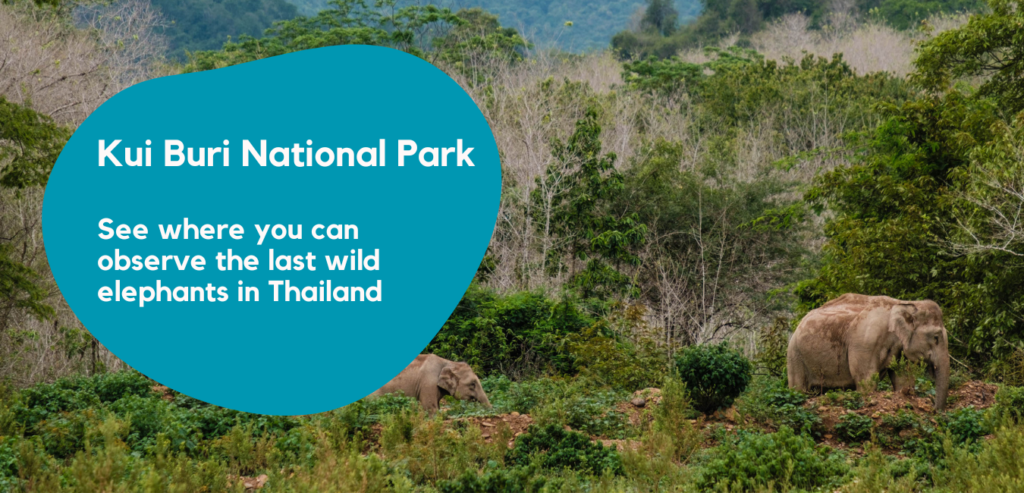How are elephants treated in Thailand? Well… it depends. It depends on the location, the people, the conditions, and the money involved. There’s no single answer; nothing here is black and white. Why is it worth reading up a bit about elephants before visiting them in a reserve or sanctuary? Why is conscious tourism so important in Asia? How do you find an ethical place for elephants where their well-being is truly prioritized?
I hope my text will help you form your own opinion on this matter.
I wrote this text based on conversations with Thais, foreigners who have been living in Thailand for years, and individuals who have witnessed the cultural shift in how elephants are treated. I’ve also watched numerous documentaries, viewed footage from the past few years, read reports from international organizations, and explored travel blogs. I wanted to understand the situation of elephants within a larger context, beyond just our personal Thai experiences.
Special thanks to Jacek from Chiltours.pl, with whom I spent hours discussing elephants (by the way, Jacek was the one who showed us one of the first elephant sanctuaries in the mountains near Chiang Mai 7 years ago).
O tym przeczytasz
- 1 So, what’s the deal with elephants in Asia?
- 2 Did you know that in Thailand, the elephant population has decreased by almost 98% in just 100 years?
- 3 And here begins another issue – elephants in Thailand
- 4 Elephant Sanctuaries – A New Approach to Solving the Elephant Problem?
- 5 How to find ethical elephant sanctuaries?
- 6 Alright, but are elephants in sanctuaries really happy?
- 7 Lanta Elephant Sanctuary, Koh Lanta
- 8 Is it worth going to an elephant sanctuary? Absolutely, yes!
- 9 Stay with us for more!
So, what’s the deal with elephants in Asia?
Elephants in Thailand, and more broadly in Asia, are a complex topic. A single blog post is hardly enough to describe the situation of these animals. Keep in mind that…
when forming judgments about a topic, especially one related to a different culture and geography, context always needs to be considered.
It’s very easy to judge someone’s behaviour based on one or two internet videos or a single Instagram post.
And when the issue involves the treatment of animals or children, we tend to generalize automatically. I don’t hide the fact that I’ve done this many times, despite my sociological education and openness to the world. Our brains like simple, black-and-white solutions.


But let’s get to the point – what’s the deal with elephants? Elephants are an undeniable, sacred symbol of Thailand, and many Thais have a special, almost magical bond with them. However, for decades, they were taken from the jungle, their natural habitat, to be used for work in the military or industry. Later, they became working animals. But in order for an elephant to follow human commands, it had to be tamed first.
★
Did you know that in Thailand, the elephant population has decreased by almost 98% in just 100 years?
According to data from WWF and other international organizations, there are now around 3000-3500 wild elephants in Thailand. The Asian elephant has been listed as endangered in all countries where it is found (similarly to the African elephant).
In Thailand, there are a few places where you can see wild elephants in their natural environment. One of them is Kui Buri National Park, which my whole family visited. It was an unforgettable experience.
And here begins the bloody, unfortunate history. Because taming such a huge, wild, independent, and strong animal is no easy feat. This practice is called “breaking the spirit,” and it’s essentially cruel, brutal mistreatment of the animal. You can read more about it in my emotional article from 7 years ago – “Do Happy Elephants Exist?”
However, to put it briefly and simplistically, when Thailand enacted laws in 2014 restricting the use of elephants for work in farming and logging (Animal Welfare Act: “Prevention of Cruelty to Animals and Animal Welfare Act”), WWF and other local organizations began raising awareness about the issue. Harsh practices involving the adaptation of these wild animals to human work were officially banned.
Thus, a way to support these elephants needed to be found. Elephants that had been broken or born in captivity couldn’t be sent back to the jungle. They wouldn’t survive there.
★
And here begins another issue – elephants in Thailand
Because an average elephant consumes over 150-200 kg of plants daily. Moreover, it eats continuously for 20 hours a day (sleeping the remaining 4 hours). And as we know, food costs money. A lot of money. Much more than a typical Thai rural family could afford. Fortunately (or unfortunately for the elephants), this coincided with Thailand’s growing popularity as a tourist destination.
So, elephant owners came up with the idea of “employing” these animals in tourism. Tourists from Europe, America, Australia, and recently China began riding elephants, taking photos while sitting on their trunks, applauding when elephants painted with their trunks, scored goals or stood on their hind legs.
In the early 21st century, riding an elephant was not shocking; it was normal. Watch videos on YouTube from that time.
And because there were more tourists eager for such “exotic” and easily accessible experiences, elephants started working non-stop instead of resting. The animals were subjected to continuous labour without respite. The business was thriving, and the elephant owners were increasingly satisfied. The animals themselves, however, suffered more and more.

Fortunately, after several years of a tourist-driven elephant boom, international animal rights organizations, foreigners living in Thailand, and more conscious Thai individuals decided to take action.
★
Elephant Sanctuaries – A New Approach to Solving the Elephant Problem?
This is how the idea of rescuing elephants from captivity and placing them in special sanctuaries, where their basic rights began to be respected, came into being. Elephants no longer had to carry tourists on their fragile and delicate backs, endure prodding with metal rods, or be tethered to trees with short chains. They could rest and live in relative peace. At least, that was the intention.
Of course, like any change, this also required time. Ethical elephant sanctuaries first started appearing in northern Thailand. As awareness grew among online travel agencies, and instead of offering elephant rides, they began organizing trips to such ethical places, the demand for elephant tricks decreased. However, the interest in observing elephants in their daily routines grew.
And the business started booming again. Tourists began paying to feed elephants, apply mud on them, walk them to the pond, scrub them with brushes, or participate in other elephant-related activities. However, as you can imagine, the world we live in is far from perfect. Alongside ethical sanctuaries, pseudo-sanctuaries began popping up, places that claimed to care for elephants officially but unofficially continued to use drastic methods to “care” for the animals.





★
How to find ethical elephant sanctuaries?
There are quite a few ethical elephant sanctuaries, also known as elephant sanctuaries. How to find them? First of all, read reviews on Google or on social media. Look at photos or videos of people who tag themselves in such places. Usually, a fifteen-minute research will help you answer whether a place is ethical or not.
Also, take a look at the daily program available on the sanctuary websites. How often are tours organized? How large are the groups they accommodate? How much does admission cost? A light should go on in your head if you see that visits are organized, for example, every hour, elephants bathe 10 times a day, and groups exceed a dozen people.


★
Alright, but are elephants in sanctuaries really happy?
And this is the question for which there probably isn’t a clear answer. How can we know if an elephant really wants to bathe three times a day instead of two? Does an elephant want to eat a basket of bananas at 12:00, or would it rather play in the mud at that time? Or do elephants really not mind being approached by 20 or 30 people every day?
Similar questions can be asked to Moroccan camel owners, Polish stable owners providing horseback riding lessons, dog owners, or other animals kept in cages, terrariums, and aquariums. And what about zoos? Here too, a similar discussion can be opened.
Certainly, elephants would be happier in their natural environment. But in the vast majority of this natural environment, there’s no longer any room. The forest area in Thailand has decreased from 80% to 20% in the last 70 years. And each adult elephant needs at least 100 km2 to provide enough food.
However, if we stop visiting sanctuaries, they will lose their primary source of income – tourist money. And lack of money means a lack of food for the elephants. It’s a vicious circle. These are the consequences of human actions. Something we did 200 or 50 years ago has its reflection today, and we have to deal with it.

★
Lanta Elephant Sanctuary, Koh Lanta
One such ethically run sanctuary for elephants on Koh Lanta is the Lanta Elephant Sanctuary. The place is intimate and currently houses 3 female elephants: Dookdik, Mali, and Srisook. The sanctuary is open every day, and you can choose from three programs. The shortest option costs 1800 THB (approximately 235 PLN), and the most expensive and longest is 4000 THB (approximately 520 PLN). The sanctuary’s staff can pick you up from your hotel and take you back after the tour.
Additionally, Lanta Elephant Sanctuary has a very well-managed policy of caring for visitors. On the sanctuary’s website, you can find plenty of useful information about the elephants’ lives and how you can get involved. It’s really helpful.
I think it’s especially worth taking children to such a place.
The stories from the guides, the opportunity to experience “skin to skin” with such a massive and majestic animal, truly leave a lasting impression. And kids, according to the ancient principle of Confucius, “Tell me and I will forget, show me and I may remember, involve me and I will understand,” after such a visit, they become natural ambassadors defending elephants. Seriously, when we first visited such a sanctuary 6 years ago, Marianka, who was just under three years old at the time, would angrily repeat whenever she saw someone riding an elephant, “But you’re not allowed to ride elephants!”


★
Is it worth going to an elephant sanctuary? Absolutely, yes!
During such a visit, you can truly learn a lot about the elephants’ situation, their lives, and have direct contact with them. The staff in these places usually have lived with the elephants for generations, so they know almost everything about them.
And as I mentioned earlier, by visiting ethical elephant sanctuaries, you’re truly contributing to improving the lives of these animals – almost all the ticket money is used for feeding and maintaining the sanctuaries. And that’s something worth doing always, regardless of everything else.




★





